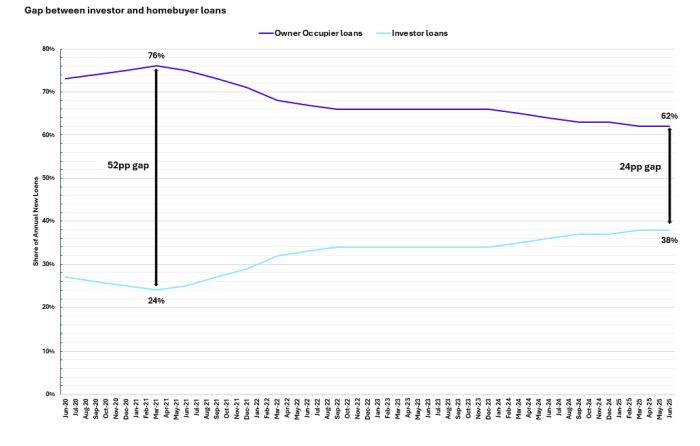
Key takeaways
Property investors now make up 38% of all new lending, the highest share on record, up sharply from just 24% in 2021.
This signals a major turning point.
The average investor loan ($667,512) is now almost identical to the average owner-occupier loan ($661,534).
This parity reflects how both groups are maximising leverage to compete in a tight market.
It’s official, property investors are back in the game.
According to new data from Money.com.au, investors now hold their largest share of the mortgage market on record, accounting for 38% of all new lending in the year to June 2025.
This narrowing gap between investors and owner-occupiers marks a major turning point in Australia’s property cycle.
Just a few years ago, investors made up only 24% of lending.
In other words, in 2021, homebuyers were absolutely dominating the market, but that balance has shifted fast.
So let's look at what’s driving this surge in investor activity? And what does it mean for prices, renters, and first-home buyers?

Why investors are surging back
When you think about it, this comeback shouldn’t surprise anyone who’s watched Australia’s property market long enough.
Investors sat on the sidelines through the uncertainty of COVID, rising rates, and tightened lending.
But now, as inflation eases and the outlook stabilises, confidence in property as an asset class is roaring back.
There’s a clear belief that the worst is behind us, and many investors are taking a long-term view, betting that Australia’s chronic housing undersupply, population growth, and strong rental demand will keep pushing prices higher.
In fact, the average investor loan now sits at $667,512, almost identical to the $661,534 average loan for owner-occupiers.
That’s remarkable parity, considering that investors typically take on larger debts, according to Money.com.au.
It shows just how much leverage both sides of the market are now using to stay competitive.
The double-edged sword of investor dominance
As Money.com.au’s mortgage expert Debbie Hays pointed out, this surge in investor activity is a double-edged sword.
On one hand, it’s a sign of renewed faith in Australian property.
When experienced investors start borrowing again in record numbers, it tells you that confidence has returned, and they expect capital growth ahead.
But there’s another side to this story: it’s making life tougher for first-home buyers.
Investors often come armed with equity, experience, and borrowing capacity that newcomers simply can’t match.
As they snap up limited stock, they push prices higher, widening the affordability gap and locking out more aspiring homeowners.
This is where government policy could re-enter the debate.
With investors now taking such a dominant share of new lending, it wouldn’t be surprising to see negative gearing or capital gains tax reforms make their way back into the political conversation.
What this means for renters
You might assume that more investor activity would ease rental pressure; after all, investors typically add new properties to the rental pool.
In theory, yes. More investor-owned dwellings should increase rental supply.
But in practice, demand continues to outstrip supply by a long shot.
Rents have been climbing across every capital city, and investors, facing higher mortgage costs, will naturally seek higher rental yields to cover their loans. That means tenants are unlikely to feel much relief any time soon.
Where to from here?
We’re seeing a fascinating shift, a maturing market where investors once again hold a powerful influence over housing trends, price growth, and even policy direction.
This doesn’t mean it’s bad news. It means the market is rebalancing.
Investors play a vital role in housing supply and long-term wealth creation, but the challenge is ensuring we build enough stock to support both investors and homebuyers without fuelling further inequality.
The reality is, as long as demand continues to outpace supply, and as long as Australia’s population keeps growing, property will remain the preferred vehicle for wealth creation.
And it looks like investors know it.














